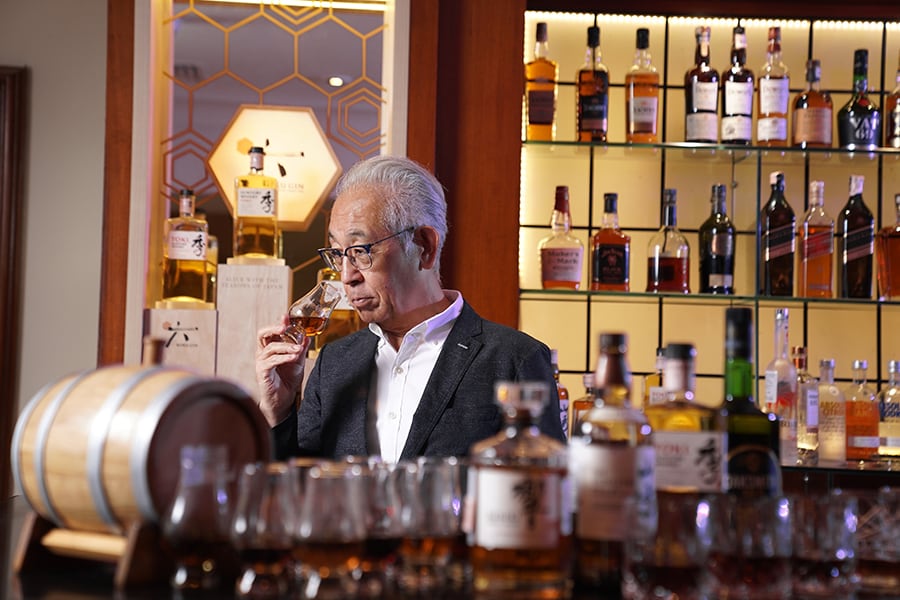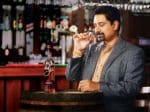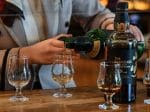Whisky is a very flexible drink: Shinji Fukuyo of Suntory Spirits
The executive officer and chief blender of the century-old, celebrated whisky brand talks about what sets apart the different brands and distilleries of the Japanese whisky maker, and how best to drink whisky
 Shinji Fukuyo, Japanese executive officer and chief blender of Suntory Spirits.
Image: Mexy Xavier
Shinji Fukuyo, Japanese executive officer and chief blender of Suntory Spirits.
Image: Mexy Xavier
As we sit for a chat on an overcast afternoon in mid-June, in Mumbai, Shinji Fukuyo asks for a masala chai. The Japanese executive officer and chief blender of Suntory Spirits Limited, which celebrated its centenary year in 2023, says he likes aromatic flavours, and to try out “spicy foods and this kind of teas” when in India.
Suntory says Oaksmith became one of the fastest brands to reach the 1 million cases mark in the Indian whisky category. Jim Beam is the highest selling whisky globally from the Suntory Global Spirits (earlier known as Beam Suntory) stable, while Oaksmith is the highest selling in India. Suntory Global Spirits, in February, announced that 2023 sales were up 7 percent year-on-year, and operating revenue rose 13 percent versus 2022. Growth was driven by the House of Suntory’s 100-year anniversary limited-time offerings and strong performance in Japan, ‘Emerging Asia’ and global travel retail.
The mind behind some of Suntory’s most popular whiskies, Fukuyo drinks his whisky in different ways, depending on the situation. While cooking on weekends—“Nothing very complex, I just check what is in the fridge, or sometimes I look up the internet for something just fried or boiled, sometimes I make curry as well, with spices,” he says—he prefers a cool and refreshing highball, just like a non-alcoholic beverage. “But late at night, for a night cap, I enjoy it straight,” he says.
In his interview with Forbes India, Fukuyo talks about the distinguishing characters of Suntory’s whiskies, the different ways in which whisky can be drunk, and how the industry is changing along with the climate. Edited excerpts:
Q. After Oaksmith was launched in India, whiskies such as Hibiki, Yamazaki and Toki have been added to the Suntory portfolio in India. How do you conceptualise different taste profiles under the same brand, and what are the differences between these whiskies?
Each of these brands was made at a different time. Yamazaki was launched in 1984, 40 years ago; Hibiki was launched in 1989, so it is 35 years old, and Toki was launched very recently, maybe 15 or 16 years ago. So, each time different ideas were available.
Yamazaki is a single malt whisky, and the main taste comes from the Yamazaki [distillery] itself; its nature, techniques and other characteristics are reflected in the whisky. Its character would be very soft, mild and sweet, but a very full-body type.
Hibiki—which means a good balance, or ‘harmony’ in English—is a blended whisky and consists of whiskies from the Yamazaki, Hakushu and Chita distilleries. In particular, Hibiki required elegance; it is not powerful, not a strong blend; it is very elegant, very aromatic and has a good balance.
Toki was first launched in America, which has a strong cocktail culture. We thought about the mixability of Toki, which is a relatively unique brand. Generally speaking, the centre of blended whiskies is a malt whisky character, like Yamazaki or Hakushi. That is supported by grain whisky, which is a much softer and lighter whisky. Toki is a blend of the heaviest grain whisky and the lightest malt whisky, almost at the same proportions. Also, we don't add too much of wood extracts from the cask. Such kind of whisky has good mixability as well.
Q. What kind of casks do you use for all three of them?
For Toki, mainly American white oak. However, Spanish oak gives a very strong, sweet and sour character, and to bring about a complexity, I blend a very small amount of Spanish oak as well. For Yamazaki and Hibiki also, we use mainly American white oak, but also Spanish oak and Japanese oak.
Q. Japanese oak, Mizunara, is known to be difficult to work with. Why is that?
During World War 2, it was very difficult to import casks and wood from abroad. So, we had to make casks using domestic trees and oaks. We started making casks using the Japanese oak since the 1940s, till the beginning of the 1970s. But Japan is very mountainous. So, oaks don’t grow just straight; sometimes the branches are twisted and winding around. It’s difficult to get very straight planks [to make the casks with]. Mizunara also grows very slowly. Inside, the tree is not very dense, and it leaks easily. Many years ago, coopers who would make the casks using domestic oak, would carve ‘J’ on the wood, which means it was Japanese oak cask, and therefore could leak. Hence people in the warehouses would have to look after them more carefully.
Also read: New Japanese whisky rules aim to deter imposters
Q. Different kinds of people in different parts of the world drink whisky in different ways. Some prefer it neat, others with ice, water or soda. What is the best way to drink Japanese whisky?
Whisky is a very flexible drink. For example, beer can just be had chilled, white wine can be a bit chilled while red wine should be at room temperature. However, whiskey can be drunk at your favourite temperature. Sometimes they chill whisky in Japan, while during winter we drink whiskey with hot water. You can also select a straight, high alcohol strength, and you can also dilute it with water. It’s very flexible. That's why it’s difficult to say which is the one way to drink Japanese whisky.
But, generally speaking, a very good highball style is good, because Japan is also a very hot and humid country; so, a highball is refreshing, aromatic, with a good taste. Drinking it straight, on the rocks, is also good.
Q. How would you say Japanese craftsmanship is different from whisky-making practices in other parts of the world? How does it make Japanese distinct from other whiskies?
Perhaps not only whisky-making, but also where manufacturing or producing watches are concerned Japanese techniques are very detailed and precise. I believe such kind of a style reflects in whisky-making as well. For every step, every process, the craftsmen, distillers, and the warehouse people are all very precise and this works every time. Even in Scotland, Kentucky, Seoul, everywhere, craftsmen try to make their own whisky better. But the Japanese style is very detailed.
Q. You started your career at Suntory’s Hakushu distillery in 1984. How are the Yamazaki and Hakushu distilleries different in the whiskies they produce?
The Yamazaki distillery was constructed 100 years ago, in 1923, and started production in 1924. So, Yamazaki has a very long history. The water and climate of the Yamazaki area is also very different from Hakushu.
Hakushu was established 50 years after Yamazaki, in 1973, built by the second master builder Keizo Sagi, who wanted to build a different style of distillery. Hakushu is at the foot of a mountain, a high mountain in the forest. The water there is different, much cooler and much softer than Yamazaki; the climate, too, is much cooler than Yamazaki.
As a result, Yamazaki is very soft, mild, sweet and high, while Hakushu is relatively lighter and crispier, and fruity. So, although the basic process is quite similar, the water and climate create such kind of differentiation.
Q. Whisky-making is dependent on a lot of environmental factors, such as quality and availability of water, soil conditions and temperature. Is climate change affecting whisky making?
We have two directions. One is to protect the current quality of water. Behind the distillery there is a huge area, where we protect nature and, if necessary, plant trees to maintain the good quality of water. This is not just with the distilleries, but also with factories of the Suntory group around the world; thinking about water is very important.
The other direction is that we have to adapt to the changing of nature, and we always explore ways—maybe try some other method or technique—in which we can keep creating good whisky with the help of nature. As a result, we probably create good quality whisky, but something different. To be honest, I expect such kind of change, and it’s a good opportunity to create new whiskies and it keeps the creativity alive.
Q. In April, Suntory announced it has successfully trialled the world's first direct-fired distillation process using 100 percent hydrogen at Yamazaki. What is the direction that the company is planning to take in this regard?
Historically, particularly in the Scotch industry, they introduced and used direct firing distillation. But around 50 or 60 years ago, it changed from direct heating to steam heating. Steam heating is much easier to control and saves energy. But from our research, we found that direct firing distillation gives a much stronger body to the spirit. We had started with direct heating, but, same as the Scotch industry, we changed to steam heating. Now we are back to direct heating. But again, direct heating consumes much more energy. We also introduced gas firing. Electricity may be in the future; it can become green energy. So, there will be no damage to the environment.
Hydrogen also has a huge potential for the future. We have small, pilot distilleries, where we had the experiment using hydrogen firing distillation. It was successful. This experiment was supported by both the Japanese and the British governments. If we can establish the process using hydrogen, maybe this is something that the company can look at across distilleries of other spirits as well within the group.
Q. Which are Suntory’s most successful markets?
Beam Suntory was born in 2014. Since then, we focussed on the US market. That’s where we introduced Toki. Japanese food and Japanese culture were becoming very popular in the US. So, along with that, Japanese whisky was able to be accepted. Fortunately, Hibiki and Yamazaki, in particular, also had good reputation in the whisky world.
So far, we are very successful in US market. In Asia, historically, we have exported our whiskey to Taiwan, and now we are also focusing on China. Korea also is keen to buy our whisky. Obviously, India is a huge whisky market, and we launched Oaksmith here five years ago. Now it's the market with the most potential, we believe.
Q. Among whisky lovers, there has always been the great divide between single malt and blended whisky. What is your take on it?
In a single malt, you can enjoy the distinct characteristics of each distillery, and the use of different casks. In blended whisky, the balance is very important. Those who enjoy blended whisky, they can also enjoy something else alongside. For example, having a conversation, or watching TV. These are good combinations. But if it is a very smoky whisky, my focus will not be on the TV or on the conversation. There's a whisky for different occasions and moods, or what you're feeling like.


















